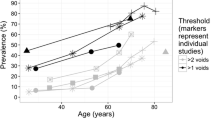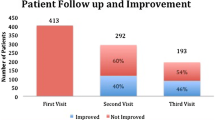Abstract
Purpose
To evaluate the efficacy and safety of desmopressin treatment in women with nocturia.
Methods
The PubMed, EMBASE, ISI web of knowledge, and the Cochrane Controlled Trial Register of Controlled Trials were searched from their inception date till April, 2019. The meta-analysis was performed by Revman 5.3. This review also stratified each outcome by dose (< 25 μg, 25 μg versus > 25 μg) to explore the differences in the dose response for orally disintegrating tablet (ODT).
Results
Seven publications with seven trials were included in this review. The methodological quality of these trials was fair, and four studies had low risk of bias. The number of nocturnal voids per night was significantly decreased by desmopressin when compared to the control [6 trials, Weighted Mean Difference (WMD) = 0.41, P < 0.00001], and the difference between < 25, 25 and > 25 μg dose ODT groups was also significant (P = 0.03). The duration of first sleep period was significantly increased by desmopressin [4 trials, WMD = 66.64, P < 0.00001], and the difference between these three doses ODT was not significant (P = 0.15). Overall, the risk ratios (RR) for 33% responder rate showed significance when compared with desmopressin to controls [3 trials, RR = 1.30, P = 0.0003]. The number of total adverse events was similar in both desmopressin and control groups [5 trials, RR = 0.95, P = 0.59], otherwise, showed no significant difference between different ODT dose groups (P = 0.82).
Conclusions
Desmopressin had certain efficacy and adequate safety in women with nocturia. The exploration of appropriate dose for female patients, and other influential factors, such as age should be conducted and considered in future.











Similar content being viewed by others
References
Everaert K, Herve F, Bosch R, Dmochowski R, Drake M, Hashim H, Chapple C, Van Kerrebroeck P, Mourad S, Abrams P, Wein A (2019) International Continence Society consensus on the diagnosis and treatment of nocturia. Neurourol Urodyn 38(2):478–498. https://doi.org/10.1002/nau.23939
Middelkoop HA, Smilde-van den Doel DA, Neven AK, Kamphuisen HA, Springer CP (1996) Subjective sleep characteristics of 1485 males and females aged 50–93: effects of sex and age, and factors related to self-evaluated quality of sleep. J Gerontol A Biol Sci Med Sci 51(3):M108–M115
Tikkinen KA, Johnson TM 2nd, Tammela TL, Sintonen H, Haukka J, Huhtala H, Auvinen A (2010) Nocturia frequency, bother, and quality of life: how often is too often? A population-based study in Finland. Eur Urol 57(3):488–496. https://doi.org/10.1016/j.eururo.2009.03.080
Kass-Iliyya A, Hashim H (2019) Nocturnal polyuria: literature review of definition, pathophysiology, investigations and treatment. J Clin Urol 12(1):60–71
Johnson TM 2nd, Burgio KL, Redden DT, Wright KC, Goode PS (2005) Effects of behavioral and drug therapy on nocturia in older incontinent women. J Am Geriatr Soc 53(5):846–850. https://doi.org/10.1111/j.1532-5415.2005.53260.x
Yokoyama O, Yamaguchi O, Kakizaki H, Itoh N, Yokota T, Okada H, Ishizuka O, Ozono S, Gotoh M, Sugiyama T, Seki N, Yoshida M, Yamada S (2011) Efficacy of solifenacin on nocturia in Japanese patients with overactive bladder: impact on sleep evaluated by bladder diary. J Urol 186(1):170–174. https://doi.org/10.1016/j.juro.2011.02.2700
Ebell MH, Radke T, Gardner J (2014) A systematic review of the efficacy and safety of desmopressin for nocturia in adults. J Urol 192(3):829–835. https://doi.org/10.1016/j.juro.2014.03.095
Taha DE, Aboumarzouk OM, Shokeir AA (2018) Oral desmopressin in nocturia with benign prostatic hyperplasia: a systematic review of the literature. Arab J Urol 16(4):404–410. https://doi.org/10.1016/j.aju.2018.06.007
Shindel A, Tobin G, Klutke C (2002) Hyponatremia associated with desmopressin for the treatment of nocturnal polyuria. Urology 60(2):344
Juul KV, Schroder MK, Mahler B, Rittig S, Norgaard JP (2019) A Danish population-based cohort study of desmopressin use in adults with nocturia or nocturnal enuresis. Low Urin Tract Symptoms 11(2):O121–O126. https://doi.org/10.1111/luts.12229
Juul KV, Klein BM, Sandstrom R, Erichsen L, Norgaard JP (2011) Gender difference in antidiuretic response to desmopressin. Am J Physiol Renal Physiol 300(5):F1116–F1122. https://doi.org/10.1152/ajprenal.00741.2010
Higgins J, Green S (2011) Cochrane handbook for systematic reviews of interventions version 5.1.0. The Cochrane Collaboration. http://www.cochrane-handbook.org
Liberati A, Altman DG, Tetzlaff J, Mulrow C, Gotzsche PC, Ioannidis JP, Clarke M, Devereaux PJ, Kleijnen J, Moher D (2009) The PRISMA statement for reporting systematic reviews and meta-analyses of studies that evaluate health care interventions: explanation and elaboration. J Clin Epidemiol 62(10):e1–34. https://doi.org/10.1016/j.jclinepi.2009.06.006
Gorgel SN, Sefik E, Kose O, Olgunelma V, Sahin E (2013) The effect of combined therapy with tamsulosin hydrochloride and meloxicam in patients with benign prostatic hyperplasia symptoms and impact on nocturia and sleep quality. Int Braz J Urol 39(5):657–662. https://doi.org/10.1590/S1677-5538.IBJU.2013.05.07
Egger M, Davey Smith G, Schneider M, Minder C (1997) Bias in meta-analysis detected by a simple, graphical test. BMJ 315(7109):629–634. https://doi.org/10.1136/bmj.315.7109.629
Begg CB, Mazumdar M (1994) Operating characteristics of a rank correlation test for publication bias. Biometrics 50(4):1088–1101
Hilton P, Stanton SL (1982) The use of desmopressin (DDAVP) in nocturnal urinary frequency in the female. Br J Urol 54(3):252–255
Lose G, Lalos O, Freeman RM, van Kerrebroeck P, Nocturia Study G (2003) Efficacy of desmopressin (Minirin) in the treatment of nocturia: a double-blind placebo-controlled study in women. Am J Obstet Gynecol 189(4):1106–1113
Weiss JP, Zinner NR, Klein BM, Norgaard JP (2012) Desmopressin orally disintegrating tablet effectively reduces nocturia: results of a randomized, double-blind, placebo-controlled trial. Neurourol Urodyn 31(4):441–447. https://doi.org/10.1002/nau.22243
Yamaguchi O, Nishizawa O, Juul KV, Norgaard JP (2013) Gender difference in efficacy and dose response in Japanese patients with nocturia treated with four different doses of desmopressin orally disintegrating tablet in a randomized, placebo-controlled trial. BJU Int 111(3):474–484. https://doi.org/10.1111/j.1464-410X.2012.11547.x
Sand PK, Dmochowski RR, Reddy J, van der Meulen EA (2013) Efficacy and safety of low dose desmopressin orally disintegrating tablet in women with nocturia: results of a multicenter, randomized, double-blind, placebo controlled, parallel group study. J Urol 190(3):958–964. https://doi.org/10.1016/j.juro.2013.02.037
Weiss JP, van der Meulen EA, Juul KV (2018) Low-dose desmopressin orally disintegrating tablet: suggested clinically meaningful benefit in patients with nocturia due to nocturnal polyuria. Eur Urol Focus. https://doi.org/10.1016/j.euf.2018.11.001
Rovner ES, Raymond K, Andruczyk E, Juul KV (2018) Low-dose desmopressin and tolterodine combination therapy for treating nocturia in women with overactive bladder: a double-blind, randomized, Controlled Study. Low Urin Tract Symptoms 10(3):221–230. https://doi.org/10.1111/luts.12169
Marshall SD, Raskolnikov D, Blanker MH, Hashim H, Kupelian V, Tikkinen KA, Yoshimura K, Drake MJ, Weiss JP, International Consultations on Urological D (2015) Nocturia: current levels of evidence and recommendations from the international consultation on male lower urinary tract symptoms. Urology 85(6):1291–1299. https://doi.org/10.1016/j.urology.2015.02.043
Funding
None.
Author information
Authors and Affiliations
Corresponding author
Ethics declarations
Conflict of interest
The authors declare that they have no conflict of interest.
Research involving human participants and/or animals
All analyses were based on previous published studies; thus, no ethical approval and patient consent are required.
Informed consent
Not applicable.
Additional information
Publisher's Note
Springer Nature remains neutral with regard to jurisdictional claims in published maps and institutional affiliations.
Rights and permissions
About this article
Cite this article
Cai, X., Tian, Y., Nie, M. et al. Efficacy and safety of desmopressin in women with nocturia: a systematic review and meta-analysis of randomized controlled trials. Int Urol Nephrol 51, 1913–1923 (2019). https://doi.org/10.1007/s11255-019-02242-x
Received:
Accepted:
Published:
Issue Date:
DOI: https://doi.org/10.1007/s11255-019-02242-x




